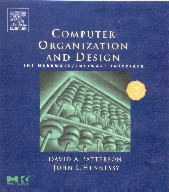 |
| (Textbook. Click for information.) |
Computer Organization II
Fall 2004
Recitation 5
Function Calls, Parameters,
and Automatic and Static Variables
Week 5: Sep 20-24
Due (on time): 2004-09-29 23:59:59
Due (late): 2004-10-03 23:59:59
Recitation 5 must be submitted
following directions at: submissions on or before
|
Outline: This laboratory practices function calls and the use of parameters (including an array as a parameter), and works with the representation of static and automatic variables. You must allocate an array on the stack as an automatic variable. Note that you were given code for one of these functions (writeArray) as part of a course handout about arrays: writeArray. This version of writeArray uses the array index approach, rather than the pointer approach. An earlier handout focused on array versus pointer notation, as discussed in your text, section 3.11, pages 171-174. This example shows two ways to print arrays, though it does not use a function for this: array2.s. Finally, the code below asks you to make use of an array allocated on the stack (the array C below), and the following course handout shows how to do this: array on the stack. (In this code, the line add $sp, $sp, -40 allocated 10 words on the stack. Then the numbers 10, 20, ... are stored into this array, and finally writeArray is used to print them.)
| Third Program (C) | C Run and Output |
|---|---|
#include <stdio.h>
int computeArray(int [], int );
int addUp(int , int , int );
void writeArray(int [], int );
/* global arrays, first initialized */
int B[] = {10, 20, 30, 40, 50,
60, 70, 80, 90, 100};
int A[10];
void main(void) {
int n, r;
scanf("%i", &n);
writeArray(A, n);
r = computeArray(A, n);
printf("%i\n", r);
writeArray(A, n);
}
int computeArray(int A[], int n) {
int C[10];
int i;
for (i = 0; i < n; i++) {
C[i] = addUp(A[i], B[i], i);
A[i] = C[i] + 100;
}
writeArray(C, n);
return C[0];
}
int addUp(int x, int y, int z) {
return x+y+z;
}
void writeArray(int A[], int n) {
int i;
for (i = 0; i < n; i++)
printf("%i ", A[i]);
printf("\n");
}
| % lab5 10 (input) 0 0 0 0 0 0 0 0 0 0 10 21 32 43 54 65 76 87 98 109 10 110 121 132 143 154 165 176 187 198 209 % lab5 6 (input) 0 0 0 0 0 0 10 21 32 43 54 65 10 110 121 132 143 154 165 |
You must transform this C code faithfully into MIPS assembler code, meaning that you do the following:
Also:
|
Contents of submission
for Recitation 5: Last Name, First Name; Course Number; Recitation Number (5).
|